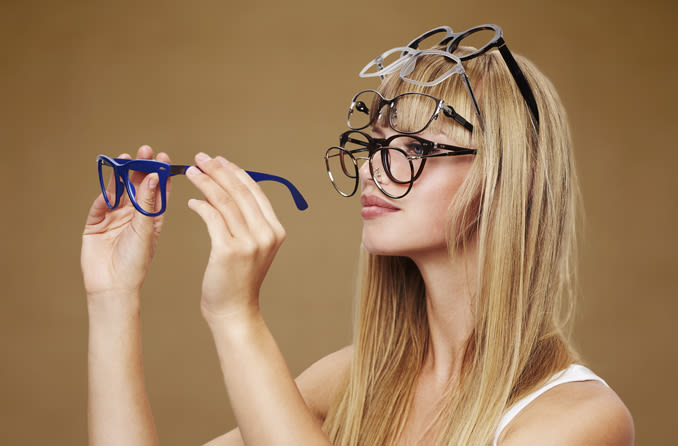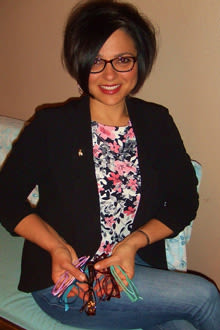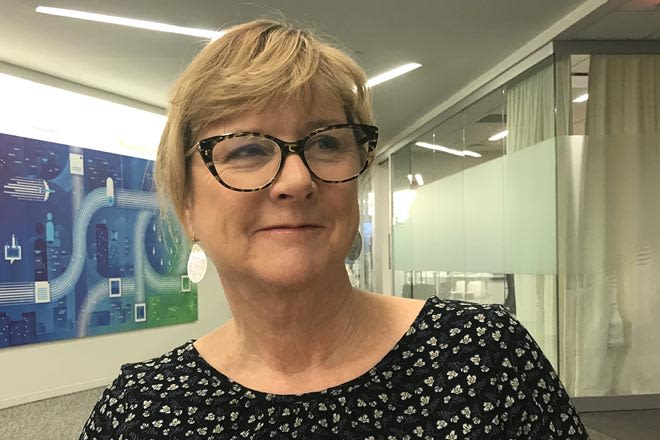How many pairs of glasses do you need?

How many pairs of eyeglasses do you need? That depends on your vision needs, your vision insurance, your budget – and even your fashion sense.
Most people get prescription eyeglasses to correct their vision, but other specialty eyewear includes computer glasses to reduce digital eye strain, polarized sunglasses to reduce glare and block harmful ultraviolet rays, readers to help you see up close, and ski goggles and sports glasses for when you’re on the slopes or riding your motorcycle.
So, how many glasses do you need?
“There are a lot more options available than there were before,” says Clifford W. Brooks, OD, FAAO, of the Indiana University School of Optometry. “But people don’t consider specialty eyeglasses because they don’t recognize that they would be helped by them.”
Meet some people who have more than one pair of spectacles — and in one case nearly as many glasses as some people have shoes.
Sunglasses
Sunglasses are more than just a fashion accessory. Sunglasses are your first line of defense to protect your eyes against the damaging ultraviolet (UV) rays of the sun.
“No matter the season or the location, people should protect their eyes with good quality sunglasses that block out UV light,” says American Optometric Association President Samuel D. Pierce, OD. “Even prescription glasses can be made with tints and full UV protection.”
But fashion appeal is important, too — because it's often what drives a sunglasses purchase.
Bob Matsuoka of New York City is a sunglasses devotee. “They are like shoes for me!” He stores a couple of dozen non-prescription pairs in a repurposed cigar humidor, ready to pop on over his contact lenses for everyday wear.
“If I see a nice pair of sunglasses, I tend to get them. They’re an expression of personality and fashion — nothing practical about them,” he says.
Matsuoka’s spectacles collection also extends to several more functional pairs of shades for his outdoor activities. Two pair are side-shielded to block the wind when he’s riding his electric skateboard, and he has three sets of snowboarding goggles.
Reading Glasses
After age 40, virtually everyone starts noticing small print gets harder to read. This normal vision change is called presbyopia, and it’s a sign that it’s time for an eye exam — and possibly a prescription for progressive lenses or custom reading glasses.

Leigh Ann Newman, who had trouble reading, now has eight pairs of readers. (Photo provided by Leigh Ann Newman)
When Leigh Ann Newman of Cavendish, Idaho, first had trouble reading, she consulted her eye doctor. Though a prescription was not yet necessary, the doctor suggested over-the-counter reading glasses.
Available virtually everywhere, these reading glasses are typically inexpensive and come in a wide range of magnifications, colors and styles.
“I have found them at airport specialty shops, hospital gift stores, the local grocery and even the dollar store,” Newman says, adding that she now owns eight different pairs, none of which cost over $20.
“Deciding to accessorize with my glasses has made the transition fun rather than depressing.”
Vivian Young, of Los Angeles, confesses to a “mild obsession” with readers that developed after she lost her first (and only) pair of prescription reading glasses in less than a week.
“My eyeglass wardrobe is extensive and makes quite a sartorial statement,” Young says. “My readers include cat eye, rimless, aviator, rectangular tortoise shell, plastic, round, half-eye — and all different colors!”
Computer glasses
Our increasing dependence on digital devices — including computers, tablets and smartphones — has created a new category of vision problems known as digital eye strain. Symptoms include dry and irritated eyes, blurred vision, light sensitivity and headache.
It is possible to use single vision lenses for computer glasses that are specially prescribed for the one viewing distance you typically use, Indiana University's Brooks says. A much better solution, he adds, is occupational progressive lenses that are especially designed for digital devices and your computer screen.
Occupational, or "office," progressive lenses will allow the wearer to see clearly at the intermediate and new viewing distances needed to relieve the discomfort of digital eye strain (also called computer vision syndrome).

Clifford W. Brooks says he was surprised at the difference his own pair of computer glasses has made in his comfort level. (Photo provided by Clifford W. Brooks)
For greater comfort, computer glasses should include anti-reflective coating. Some eye care professionals also recommend including a blue light screening component that filters blue light.
Brooks points out that specially prescribed computer glasses provide significantly greater comfort than regular progressive lenses or bifocals when viewing a computer screen..
“The only way that screen is going to be clear (with regular progressives or bifocals) is if you tilt your head back to see it. That’s uncomfortable and you can’t really get a good, clear view,” Brooks says.
Brooks says he was surprised at the difference his own pair of computer glasses has made in his comfort level, and he recommends them for people who spend a lot of time working in front of a screen.
Sports glasses
Approximately 30,000 individuals end up in emergency departments in the U.S. each year with sports-related eye injuries, according to a study published by JAMA Ophthalmology. Some of the injuries result from people wearing everyday eyewear that does not meet the safety and performance standards required for sports and athletic use
Many of these potentially sight-threatening injuries could be prevented with eyeglasses that enhance sports performance.

Raja Hamid relies on glacier glasses with photochromic lenses that block out the sun along the edges for mountain biking. (Photo provided by Raja Hamid)
The protective sports glasses category includes safety glasses and goggles, safety shields and eye guards designed for a particular sport.
“Sports eyewear is made of stronger materials and designed for ultimate impact resistance and durability,” says Pierce. “It is also designed for ultimate comfort, fit and coverage to protect from elements, such as sun, water or wind.”
New York City resident Raja Hamid relies on three different types of protective glasses while sporting.
For biking at night, he wears clear, wrap-around lenses to protect his eyes from airborne dust and debris. While mountain biking, he sports pricey glacier glasses with photochromic lenses and sun-blocking side shields.
For rock climbing, Hamid uses belay glasses — sport glasses with special prism lenses that expand the wearer's vertical field of view.
“I use the belay glasses when I’m on the ground and my partner is climbing up a rock face or gym wall, rather than craning my neck up to watch them as I feed out rope,” Hamid says.
Fashion
Finally, eyeglasses as a fashion statement is a definite fad, one that even The Wall Street Journal weighed in on recently.
In Atlanta, Danica Kombol has assembled a collection of on-trend glasses for different occasions that reflects her inner fashionista.
“My daily specs are large, geeky glasses. I work in social media, so it matches my brand,” she says. “For evening, I have a pretty pair of blue-tinted Prada glasses that are much softer and signal a more glam look.
“I even have glasses for gardening — an old pair that I don’t mind getting splattered by dirt,” Kombol adds.

Carol Wallace never wants to scramble to find her glasses, so she has multiple pairs stashed around her home and office. (Photo provided by Carol Wallace)
One final reason some people have more than one pair of glasses? They want to have a spare.
“I grew up with a wonderful mother who spent 15 minutes every morning asking, ‘Where are my glasses?’ I wanted to make sure I was never that person!” says Carol Wallace of Greenwich, Connecticut.
Wallace now has a dozen inexpensive readers in five different styles and multiple colors stashed around her home and office that she can grab as needed.
Can one or more of these specialty eyewear options work for you? If you work on a computer screen all day, computer glasses can protect your vision as well as make it easier to read what’s on your screen. If you spend a lot of time outside — or your kids do — sunglasses are a must to safeguard your sight.
Check with your eye doctor and ask for recommendations about which lenses, coatings and frames are the best choices for your specific needs. And don’t forget to ask if your vision insurance will help you save money on your eyewear purchases.
Page published on Tuesday, March 5, 2019






